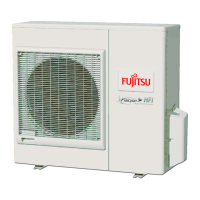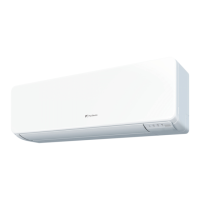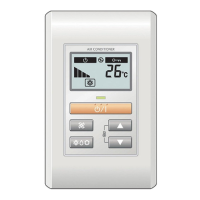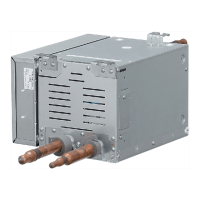4. Tightness test
(1) After completing all piping connection, always carry out an air tight test to check and confirm that there is no gas leakage.
Charge the piping with nitrogen to within the sealing test pressure (2.94 MPa). After 24 hours, check that the pressure has
not fallen. Make sure to add the pressure to both gas pipe and liquid pipe. Perform the leak test on all flared and brazed parts.
Note: When the ambient temperature changes 5 deg. , the test pressure changes 0.05MPa.
(2) After tightness test, please insulate the connecting portion, apply the enough insulation to avoid any gap.
5. Vacuum process
(1) Do not purge the air with refrigerant but use a vacuum pump to remove air from the indoor units and connection pipes!
(2) Remove the cap, and connect the gauge manifold and the vacuum pump to the charging valve by the service hoses.
(3) Vacuum the indoor unit and the connecting pipes until the pressure gauge indicates -76 cmHg.
(4) When -76 cmHg is reached, operate the vacuum pump for at least 1 hour.
(5) After vacuuming inside the indoor unit and connecting pipes,remove the cap of the two valves.
(6) Open the handle (spindle) of the Large and middle valves(Ball valve).
Open the spindle of the Small valve(3 way valve) with a hexagon wrench.
(7) Tighten the cap of the two valves to the specified torque.
6. Additional charge
(1) Be careful, don't charge with wrong refrigerant!
(2) When moving and installing the air conditioner, do not mix gas other than the specified refrigerant inside the refrigerant
circuit.
(3) When charging the refrigerant, always use an electronic balance for refrigerant charging. (to measure the refrigerant by weight)
(4) R407C is a mixture of 3 refrigerants with different evaprotion temperature. The composition changes if it is charged in gas
phase. Therefore always charge from the liquid phase side whose composition is stable.
(5) Always add the refrigerant for the appropriate amount. (For the calculation method, please refer to 6-1"ADDITIONAL
CHARGE")
(6) Either larger or smaller refrigerant charge amount leads to the cause of trouble.
(7) For after service purpose, the added refrigerant charge amount and the calculation shall be indicated firmly on the service
label over the control box cover.
Tightening torque
Ball valve 3 way valve
Spindle
(handle)
15 kgf cm (1.47 N m) or less
100 to 120 kgf cm
(9.8 to 11.7 N
m)
Cap
150 to 200 kgf cm 200 to 250 kgf cm
(14.7 to 19.6 N m) (19.6 to 24.5 N m)
Ball valve (Discharge Gas)
Open valve state Closed valve state
Open
Close
Hexagon wrench
Spindle
3 way valve
If the spindle (handle) is not fully open,
performance will degrade and an abnormal
sound will be generated.
3 way valve
Small pipe
Middle pipe
Large pipe
Charging valve
Cap
Ball valve (Suction Gas)
Open valve state Closed valve state
06-12

